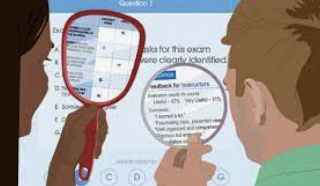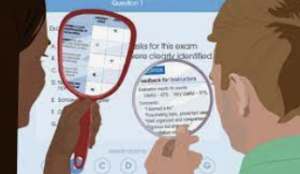Online/blended learning pedagogical practices are organized into three categories: Course Content, Interaction, and Assessment. Assessment is a fundamental component of the educational process that involves evaluating and measuring students’ knowledge, skills, attitudes, and understanding. It serves as a tool to gauge the effectiveness of teaching methods and learning outcomes. Assessments can take various forms, including quizzes, exams, essays, projects, presentations, and practical demonstrations.
Key Functions of Assessment:
- Measuring Student Learning: Assessments provide insights into how well students have grasped the course material.
- Providing Feedback: They offer valuable feedback to students on their progress and areas needing improvement.
- Informing Instruction: Assessments help instructors identify which teaching strategies are effective and which need adjustment.
- Motivating Students: They encourage students to engage with the material and strive for improvement.
- Ensuring Accountability: Assessments hold both students and educators accountable for the learning process and outcomes.
Effective assessment strategies are aligned with course objectives and are designed to be fair, transparent, and supportive of student learning.
Featured Articles
Collect Student Feedback Using Course Evaluations
When instructors adopt the stance that course evaluations are an opportunity to improve courses and decidedly use this as an opportunity for changes to be made, better-quality teaching arises (Golding & Adam, 2016).Read More
Collect Student Feedback Using Course Evaluations
When instructors adopt the stance that course evaluations are an opportunity to improve courses and decidedly use this as an opportunity for changes to be made, better-quality teaching arises (Golding & Adam, 2016).Read More
Recent Articles
- Press Release: 2024New Online Teaching Strategies Now Available in Open Repository Orlando,…
- The Power Flower: An Inclusion and Diversity ActivityThis strategy is designed to enhance students’ awareness of multiple intersecting identities that they have. It can be used for fostering inclusion and promote diversity in a classroom. It encourages students to accept others and work with others with respect.
- More Inclusive Assessment: Applying the UDL Framework and Transparent Assignment Design (TAD) to Reimagine a Writing Assignment as a Multimedia Asynchronous DiscussionThis entry demonstrates application of the Universal Design for Learning (UDL) Framework combined with Transparent Assignment Design (TAD) to develop more inclusive assessments. The artifact is an asynchronous online sociology class on gender and sexuality. An assessment that was previously a written paper was revised using UDL and TAD to provide flexible demonstration of learning through a multimedia asynchronous discussion using VoiceThread.
- Adapting the Canvas Quiz to Practice Verbal CommunicationWith more higher education experiences moving online, students have fewer…
- Set High Expectations for Low-Stakes Discussions Using a Complete/Incomplete RubricThis strategy highlights the benefits of using a Complete/Incomplete, single-criteria rubric for online discussions to increase student success and reduce instructor grading.
- Using a Business Proposal to Develop Students’ Problem-Solving Skills and EntrepreneurshipThe current technology-infused and globalized job market is putting pressure…
- Use Large Language Models to Simulate Professional Roleplaying as Opportunity for Authentic AssessmentLarge Language Models (LLMs) that generate text, such as OpenAI’s…
- Apply the DEAL Model of Critical Reflection to Maximize Learning in BlogsStudent learning is more impactful when meaningful reflection is integrated…
- Incorporate Online Group Assessment Through Virtual PostersAssessing knowledge for individual students online can be a challenge,…
- Digitalizing Gallery Walks: A Method for Student-Centered Feedback and EngagementTraditional gallery walks let students stroll through the classroom viewing…
- Boosting Engagement in Research in a Synchronous Online Foreign Language Class: Using an E-Conference Format, Peer-Reviewing and PressbooksIn the COVID new normal, many courses have changed modality…
- Incorporate Online Student Personas to Promote Faculty Empathy and ReflectionMost often, the conversation about personas in higher education has…
- Using Collaborative Exams to Reinforce and Deepen LearningShifting the passive classroom environment of a faculty lecturing and…
- Promoting Interaction and Engagement in Synchronous Classes: Four ExamplesPlanning synchronous classes, such as Zoom sessions, can be challenging,…
- Offering Assessment Options: Motivating Learners through Multiple Means of Action & ExpressionOne of the tenets of Universal Design for Learning (UDL)…
- Streamlining Placement Testing with an Adaptive, Branched ExamDigital technologies are widely used in language teaching and testing…
- Enhancing Competency-Based Education with Virtual Reality SimulationCompetency-based education (CBE) is an alternative modality of learning. Instead…
- Using Zoom Polling Feature to Increase Student Engagement and LearningQuizzes are a well-established method for testing student understanding, in…
- Use Digital Badges to Scaffold and Guide Student LearningTraditionally, student learning has been recognized and stored through the…
- Disrupt the One-Way Street of Feedback to Encourage Reflective PracticeTraditionally, feedback on student work is a one-way communication from…
- Use Criteria Starters to Develop Rubrics Based on Knowledge Levels to Provide Accurate Feedback to StudentsEducators are encouraged to provide informative feedback to students as…
- Create a Case Method Group Activity to Engage Students in Critical ThinkingThe case method group activity is an instructional design strategy…
- Using Standards-Based Rubrics to Facilitate Online Peer Assessment, Response, and ReflectionWhile traditional rubrics can more clearly convey to the student…
- Build an ePortfolio to Showcase Mastery of 21st Century SkillsToday’s employers expect their potential workers to be conversant in…
- Embed Interactive Questioning within Course ContentFaculty are often using images and other artifacts to “chunk”…
- Using Buttons to Chunk Assignment Instructional StepsIt’s no secret that many students feel negatively about online…
- Use Web Conferencing and Videos to Improve Interview SkillsAs university graduates enter into complex and rapidly changing job…
- Using Pre and Post-Tests to Close Gaps in KnowledgeA challenge most academics experience is delivering courses which assumes…
- Using Video Discussion Boards to Increase Student EngagementDiscussion boards in online courses are widely known to encourage…
- Using Low-Stakes Quizzes to Encourage MasteryInformation retention and transfer can be enhanced when a learner…
- An Alternative Strategy for Using Online Discussions for Learning Course Content in STEM CoursesOnline discussion boards offer students an opportunity to engage with…
- Implement the Universal Design for Learning (UDL) Framework by Providing Learners with Options for How to Express What They KnowResearch has shown that by providing learners with choices in…
- Incorporate Online Debates to Stimulate Critical Thinking and EngagementOnline debates have been found to elicit higher levels of…
- Support Students to Use Multimedia in Discussion ForumDiscussion forums are commonly used in online courses because…
- Foster Meaningful Learning with Renewable AssignmentsDifferent from a traditional disposable assignment, a renewable assignment is…
- Use Mind Watch Journals to Reflect and Connect to ContentAccording to Facing History and Ourselves (2017), “a journal is…
- Using Images to Encourage Visual Creativity, Display Comprehension, and Application of a LessonEducators can use a creative way to encourage students to…
- Develop Critical Thinking Skills through Online Simulations Created with Blackboard’s Testing ToolSimulation with sophisticated manikins or standardized patients has firmly established…
- Use a Reflective Online Discussion Activity to Help Students Solidify LearningIn order to build the scaffolding for learning, students need…
- Foster Creativity, Collaboration, and Student Choice using Digital StorytellingWhen an assignment offers students an opportunity to demonstrate learning…
- Use Rubric Rationale to Improve Student Performance on Peer Review AssignmentResearch shows that students perform better when the rubric provided…
- Implement Tuning Protocol to Improve Online Discussion Peer Replies and Assignment QualityAsynchronous discussions are often utilized in online courses and while…
- Develop Student Confidence in Using the Online Library DatabaseIn any course where the assessment is focused on scholarly…
- Create Contracts to Improve Communication and Reduce AnxietyIt is very important to design an online course in…
- Assign Six Word Memoirs for Reflection and SynthesisSimilar to the six-word story from the flash fiction genre,…
- Individualize Assignments in an Online CourseIndividualizing assignments in an online course promotes student and instructor…
- Provide Non-Linguistic Representations to Foster ReflectionNonlinguistic strategies require students to create a representation of new…
- Require Online Exit Tickets for Active EngagementExit tickets are an easy way to assess student learning and can provide evidence of mastered content or misunderstandings as well as help students to self-reflect on their understanding of content.
- Stop and Pause for Engagement in Online Video LecturesWhen the majority of instruction takes place in an online…
- Strengthening STEM Laboratory Assessment Using Learner Portfolio and Electronic AssessmentWeekly lab reports are an integral part of the foundational…
- Present Homework through VideosIt can be difficult to build a sense of community…
- Use Academic Challenges and Experiential Missions to Provide Learner Choice and Engage Students in Online Course ActivitiesAligning students’ instructional preferences with course activities and providing opportunities…
- Use Online Debates to Enhance Classroom EngagementA debate is a formal competition between two teams, usually…
- Use Student Created Discussion Prompts for Peer ReviewReading assignments are often the basis for understanding much of…
- Use Learner Created Videos for Student Engagement in a Flipped ClassroomIt has been a challenge to engage students in large-enrollment…
- Using Student Created Blogs as a Progressive Formative Assessment in an Online STEM CourseThe utility of writing assignments to enhance learning biology is…
- Assess Individual Learning from Group ProjectsWhile many instructors across instructional venues integrate collaborative activities that…
- Use a Guided Approach to Support Critical Thinking in Online DiscussionsSupporting college students to develop critical thinking skills is an…
- Use Word Clouds to Enhance Critical ThinkingOne of the major goals of higher education is to…
- Use Video Self-Modeling Software to Strengthen Reading and Speaking FluencyVideo self-modeling (VSM) is an effective and engaging method for…
- Use Minute Paper to Evaluate Student ParticipationThe minute paper is a formative assessment strategy whereby students…
- Incorporate a Syllabus Quiz to Orient StudentsIn the online environment, it is important to provide clear…
- Assess Authentic Learning with Student-Generated Social VideosStudent generated video; have students create their own videos to…
- Use Self Tests to Guide and Motivate Students’ LearningSelf‐assessment can play a central role in learning, revisions and…
- Provide Formative Feedback for Student Success in Interactive AssessmentsResearch suggest that faculty interacting with and providing constructive feedback…
- Use Problem-Based Learning to Develop Students’ Course Related SkillsProblem-Based learning Problem-Based Learning is an instructional strategy in which…
- Use Group Evaluation to Assess Group WorkIn team-based learning, students work in groups on outcome-based or…
- Evaluate the Usefulness of Technology Tools in Teaching and LearningResearch has shown that technology doesn’t really guarantee learning, but…
- Create Discussion RubricsWhile faculty might hope that students can “just discuss” a…
- Collect Student Feedback Using Course EvaluationsWhen instructors adopt the stance that course evaluations are an opportunity to improve courses and decidedly use this as an opportunity for changes to be made, better-quality teaching arises (Golding & Adam, 2016).
- Reduce CheatingThere are five common academic dishonesty practices. Online faculty members…
Do you have questions, suggestions, or issues you want to share about TOPR? Please contact topr@ucf.edu.




